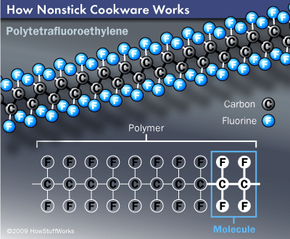Nonstick Science
In order to understand why polytetrafluoroethylene (PTFE) is a useful nonstick coating, we must take a closer look at its structure and properties. PTFE is a type of fluoropolymer. A polymer is a large molecule made up of smaller molecules of the same type. Fluoropolymers are polymers that include the fluorine atom, which is the key to many of the unique characteristics of PTFE. According to William Raiford, technology manager with DuPont Fluoroproducts, fluorine's electron structure is very stable -- it doesn't share its electrons with other atoms easily.
The chemical composition of PTFE is based on two carbon atoms and four fluorine atoms, which are repeated throughout the molecule's structure. "The molecular structure has an outer shell filled with fluorine atoms," says Raiford. "The fluorine atoms shield the carbon atoms from reacting."
Advertisement
Think about a high school dance. The fluorine atoms are the chaperones, and the carbon atoms are the female students. Anything that might interact with the carbon is the male students. As chaperones, the fluorine atoms keep the boys from interacting with the girls -- in a frying pan, it keeps the food from sticking.
Along with their resistance to reacting with other chemicals, fluorine atoms also play a role in giving PTFE a low coefficient of friction. The coefficient of friction is a measurement of how easy it is for two substances to slide by each other -- the harder it is to slide, the higher the coefficient of friction. PTFE doesn't put up a lot of resistance when sliding by another substance, giving it a low coefficient of friction. The low coefficient of friction gives PTFE that signature slippery quality.
PTFE is not the only fluoropolymer used to make nonstick cookware. According to Raiford, other polymers of the same family have been developed with slightly refined structures to offer easier application, more strength or decorative looks to the nonstick surface.
In the next section, we will answer the question of how scientists are able to get PTFE -- something that's inherently nonsticky -- to stick to metal cookware.
